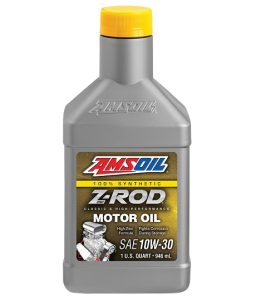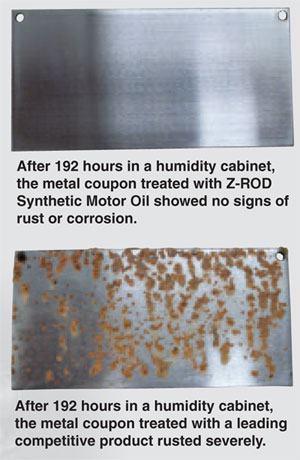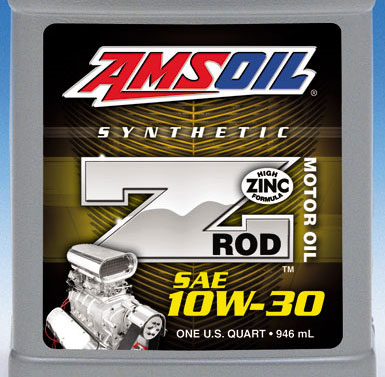Classic Car “ZDDP” High Zinc 10W-30 Synthetic
AMSOIL Z-ROD 10W-30 Synthetic Motor Oil with Zinc (ZRT)
AMSOIL Z-ROD™ Synthetic Motor Oil is specially engineered for classic and high-performance vehicles. It features a high-zinc formulation to prevent wear on flat-tappet camshafts and other critical engine components, along with a proprietary blend of rust and corrosion inhibitors for added protection during long-term storage. Z-ROD Synthetic Motor Oil is designed to perform on the street and protect during storage.
End all the debate finding a substitute or adequate motor oil for your classic hot rods. I spend a lot of time in my car club Facebook groups and forums and the topic is always being brought up.. They always conclude with “That oil is ok or this oil works great, etc” but why not have one that adds stellar performance while protects in storage?? No additives needed. And it’s not really all that expensive. If you are into your cars you should be saving $ buying by the case. So when you click on the pricing link see the blue “Preferred Pricing” AFTER choosing the case price! That will show what you really pay if you want to save. Divide that by 12 and compare that quart price with the retail everyone first sees. We want you to enjoy the best oil at the best price. This ZROD is really something you must try! My 55 Thunderbird loves it! Controls temperatures better and solve a lot of these old car “rocker arm oiling” issues.
 Specially engineered for classic cars. Contains high levels of ZDDP, top-tier additives and rust inhibitors to protect your passion, deliver maximum performance and keep your classic engine free of rust and corrosion in storage.
Specially engineered for classic cars. Contains high levels of ZDDP, top-tier additives and rust inhibitors to protect your passion, deliver maximum performance and keep your classic engine free of rust and corrosion in storage.
Printable Product Data Sheet
Download PDFProduct DatasheetPackage sizes include:
Single Quart Bottles
12 Quart Cases
I use this in all my own cars. 60 Pontiac and three Corvairs. Oil consumption is down and after using the Power Foam in a 62 Corvair that was smoking REAL bad, then FLUSH and now the ZRD 10W-30 ZROD high zinc synthetic – no more smoke at ALL!!! In my 66 Corvair which is my summer car this ZROD keeps it cool and at optimum mileage. I’ll be posting a dyno comparison in my Ford FE 390 involving Valvoline VR1 Racing 10W-30 and the AMSOIL ZROD.. I’ll post the Dyno results here soon.
Protects Flat-Tappet Cams
The lifters and cam lobes on flat-tappet camshafts common to classic and high performance vehicles slide rapidly against one another, producing high friction and heat. The friction between the two components can eventually wear down the cam and affect valve operation, ultimately resulting in lost engine power and reduced efficiency. In addition, these areas are splash-lubricated rather than pressure lubricated like other areas of the engine, which adds extra strain on anti-wear additives like the zinc and phosphorus in zinc dialkyldithiophosphate (ZDDP).
AMSOIL Z-ROD Synthetic Motor Oil is formulated with high levels of ZDDP to protect flat-tappet cams, lifters, rockers and other areas susceptible to wear. Its high-zinc, high-phosphorus formulation provides the extra wear protection these critical splash-lubricated components require.
 Provides Long-Term Protection from Rust & Corrosion
Provides Long-Term Protection from Rust & Corrosion
AMSOIL Z-ROD Synthetic Motor Oil is formulated with a unique blend of rust and corrosion inhibitors to ensure maximum protection during long-term storage. To prove its effectiveness, AMSOIL submitted Z-ROD Synthetic Motor Oil to the Standard Test Method for Rust Protection in the Humidity Cabinet (ASTM D-1748). This test evaluates the rust-preventative properties of oil under high-humidity conditions, similar to those faced by a covered hot rod in a damp garage. The metal coupon treated with AMSOIL Z-ROD Synthetic Motor Oil showed no signs of oxidation after 192 hours, while the coupon treated with a leading competitor’s product failed the test after 24 hours.
Order using the above link or join as a Preferred Customer and save even more
Save 25%Join for More Perks Preferred customer ProgramZROD Synthetic Applications
Use Z-ROD Synthetic Motor Oil in engines requiring either 10W30, 10W-40 or 20W-50 motor oil. Z-ROD Synthetic Motor Oil meets API SL and earlier specifications, allowing for increased levels of anti-wear additives. ZDDP levels in Z-ROD Synthetic Motor Oil exceed the limits of API SM and newer specifications.
General Product Compatability
AMSOIL Z-ROD Synthetic Motor Oils are compatible with conventional and other synthetic motor oils. Mixing AMSOIL Z-ROD Synthetic Motor Oils with other oils, however, will shorten the oil’s life expectancy and reduce the performance benefits. Aftermarket oil additives are not recommended for use with AMSOIL Z-ROD Synthetic Motor Oils.
Pretty much any car built from 1995 and earlier should consider this or any of the “high ZDDP” Amsoil products. There are several. If you own a car with 90,000 miles or more and you bought it used I urge you to send in an oil sample. Please read our Oil Analysis Page and order the KIT-02 with the G1206 Oil Sampling Pump (most accurate sample from suspended HOT oil).
Acids created by deposits can be dealt with using analysis, an oil designed for older vehicles and filter changes.
SERVICE LIFE
Because engines in classic cars, hot rods and other performance vehicles are generally modified, a universal oil drain interval recommendation for these applications cannot be given. Responsibility for determining the drain interval duration rests with the owner. As a general service guideline, the maximum drain interval for Z-ROD Synthetic Motor Oil should not exceed 5,000 miles or one year, whichever comes first. In heavily modified engines (e.g. forced induction, nitrous) the maximum drain interval should not exceed 3,000 miles or one year, whichever comes first.
HEALTH & SAFETY
This product is not expected to cause health concerns when used for the intended application and according to the recommendations in the Material Safety Data Sheet (MSDS). An MSDS is available via the Internet at www.amsoil.com or upon request at (715) 392-7101. Keep Out of Reach of Children. Don’t pollute. Return used oil to collection centers.
For warranty information, visit www.amsoil.com/warranty.aspx.
| Need a different high ZDDP weight? ZROD comes in 10W-40 and 20W-50 too! |

This product was designed for ALL motors with with flat tappet cams, hydraulic or solid lifters and pushrods. Basically any engine w/o roller rockers and w/o modern emission systems made after 1995. Not just hot rods and street racers. Typical daily drivers need all the anti-wear additives they can get. Pontiac 400 Trans Am, Old Triumphs, that old Chevy Caviler you want to last, you name it – consider Z-ROD 10W30!
ZROD High-Zinc motor oil Reviews
68 Olds Cutlass S
Classic car oil
Best of the best
Z -Rod oil for classic cars
Great for flat tappet lifters
Muscle Car Motor Oil
I will buy this oil again, it is the only oil to use
Best product for my application
Pretty much the best racing oil out there!
Zinc for flat tappet engines
“Three primary factors are normally responsible for oil failure” Oil that becomes too thin, too thick, or too acidic has exceeded its useful life.
 Because they work to suspend contaminants and by-products of combustion, it is not uncommon for gasoline and diesel oils to become dark. It may be more noticeable in some applications. It does not mean the oil is failing or must be changed.
Because they work to suspend contaminants and by-products of combustion, it is not uncommon for gasoline and diesel oils to become dark. It may be more noticeable in some applications. It does not mean the oil is failing or must be changed.
Fortunately, a number of different tools are available that measure motor oil’s condition and its ability to continuously protect and perform its other key functions.
When motor oil exceeds its useful life or is impacted by a mechanical defect, it most commonly becomes too thin to separate metal parts, too thick to pump or too acidic for continued use.
Too Thin
When oil becomes too thin, it fails to provide the required oil film thickness to
separate metal surfaces. Different engine designs require different starting oil thickness or viscosity. Viscosity at 100 °C is one of the most highlighted oil properties and is a good indicator of adequate oil film thickness in an engine at operating temperature.
A number of things can cause engine oil to become too thin to protect engine
parts. Excessive mechanical shear can thin oil to the point of causing issues with engine protection. As motor oil cycles through the engine, it is exposed to shear stress in the engine’s upper end, piston walls and bearings that reduces its shear strength. Continuous exposure to these conditions causes oils built with inferior shear stability to thin excessively, leaving critical engine parts susceptible to metal to metal contact.
Fuel contamination of the oil sump is another major cause of excessively thin engine oil. Both gasoline and diesel fuel are thinner than engine oil and when mixed, the oil’s viscosity, film thickness and ability to separate parts are significantly reduced. While a small amount of fuel dilution is relatively common and does not have a material impact on oil life, excessive fuel dilution in mechanically compromised equipment is much more harmful.
Too Thick
When it comes to oil, although it may seem like “the thicker, the better,” oil that is too thick is just as detrimental as oil that is too thin. Excessively thick oil is the most commonly discussed oil failure and the subject of many big oil company marketing campaigns.
When oil becomes too thick to flow to engine parts, these areas are starved of oil, resulting in metal-to-metal contact that can lead to catastrophic engine damage.
The precursor to sludge is oil that has become much thicker than its original
design. The cause is a complex chemical reaction involving heat, combustion byproducts and oxygen combining to create chemical attack on the oil molecules. The resulting chemical reaction creates a much thicker substance that does not flow or protect as well as the original oil. When the reaction continues, sludge begins to form in areas of higher localized temperature and low flow. While some varnish is normal, sludge is a sign of excessively degraded oil that needs to be replaced. In order to inhibit sludge and varnish, the oil must resist attack by oxidation forces. Synthetic base oils have a much higher level of saturated molecules that inherently resist this constant bombardment. Additionally, antioxidants are added to either reduce the formation of free-radical oxidation precursors or soak up these precursors once they form.
Another cause of oil thickening, primarily affecting diesel oils, is excessive soot loading in mechanically unsound engines. Diesel oils are designed to handle some soot contamination, but when the soot overloads the available dispersants in the oil, the oil thickens. The agglomerated soot particles reach a critical size and cause excessive wear commonly seen in diesel liners.
Too Acidic
Acids are a normal by-product of burning fossil fuels. Different fuel types, engines and combustion conditions create varying levels of acid formation. These acids, transferred via blow-by gases, are carried away to the engine oil. Oils are designed with a detergent that neutralizes these acids before they accumulate and cause engine damage. The detergent level is measured with a test called Total Base Number (TBN). This measure of alkalinity drops over the life of the oil and reaches a critical level when the oil can no longer consume the acids created by combustion. When TBN reaches a critical level,
acids build up quickly and attack the surfaces most susceptible, including yellow metals and lead-lined bearings. Without correction, this condition quickly worsens and results in excessive chemical wear. Although less common, this failure mode can cause significant damage if left uncorrected.
AMSOIL synthetic motor oils are formulated to provide a broad level of overall protection, evidenced by guaranteed extended drain intervals. Synthetic base oils help resist oxidative decomposition, and a properly balanced, high-quality additive package helps keep contaminants in check and engines running for a long time.
Diesel Oils in Vintage Cars
I frequent many old car events, shows and of course our AMSOIL store where we hear often, “Well in that old car I just use good o’l Rotella Diesel.”
That may have been a proper alternative prior to 2007 but since International Lubricants Standardization and Approval Committee pushed in CJ4 for diesel oils, these would be no better than the current gasoline motor oils. If you are dead set on running diesel oils in your favorite machine AMSOIL does have diesel oils with the original formula for CI4 or high zinc!! Call for more detail 1-800-579-0580 or use Z-ROD.
Also keep a can of Power Foam in hand with your carbureted and fuel injected classic cars!
